Business Decisions: Ethical Considerations and Decision-Making Models
VerifiedAdded on 2023/06/13
|12
|2134
|416
Essay
AI Summary
This essay provides a comprehensive overview of business decisions, emphasizing the importance of sound decision-making for the smooth operation and development of a company. It outlines the steps in the decision-making process, from identifying the problem to evaluating the results, and discusses key criteria such as purpose, ethics, timeline, and resource accessibility. The essay also explores three main decision-making models: the rational model, the bounded rationality model, and the retrospective decision-making model, highlighting their assumptions and applications in organizational settings. It concludes by stressing the significance of ethical considerations and effective leadership in ensuring positive outcomes and sustained growth for the business.

Running head: BUSINESS DECISIONS
Business Decisions
Name of the Student
Name of the University
Author Note
Business Decisions
Name of the Student
Name of the University
Author Note
Paraphrase This Document
Need a fresh take? Get an instant paraphrase of this document with our AI Paraphraser
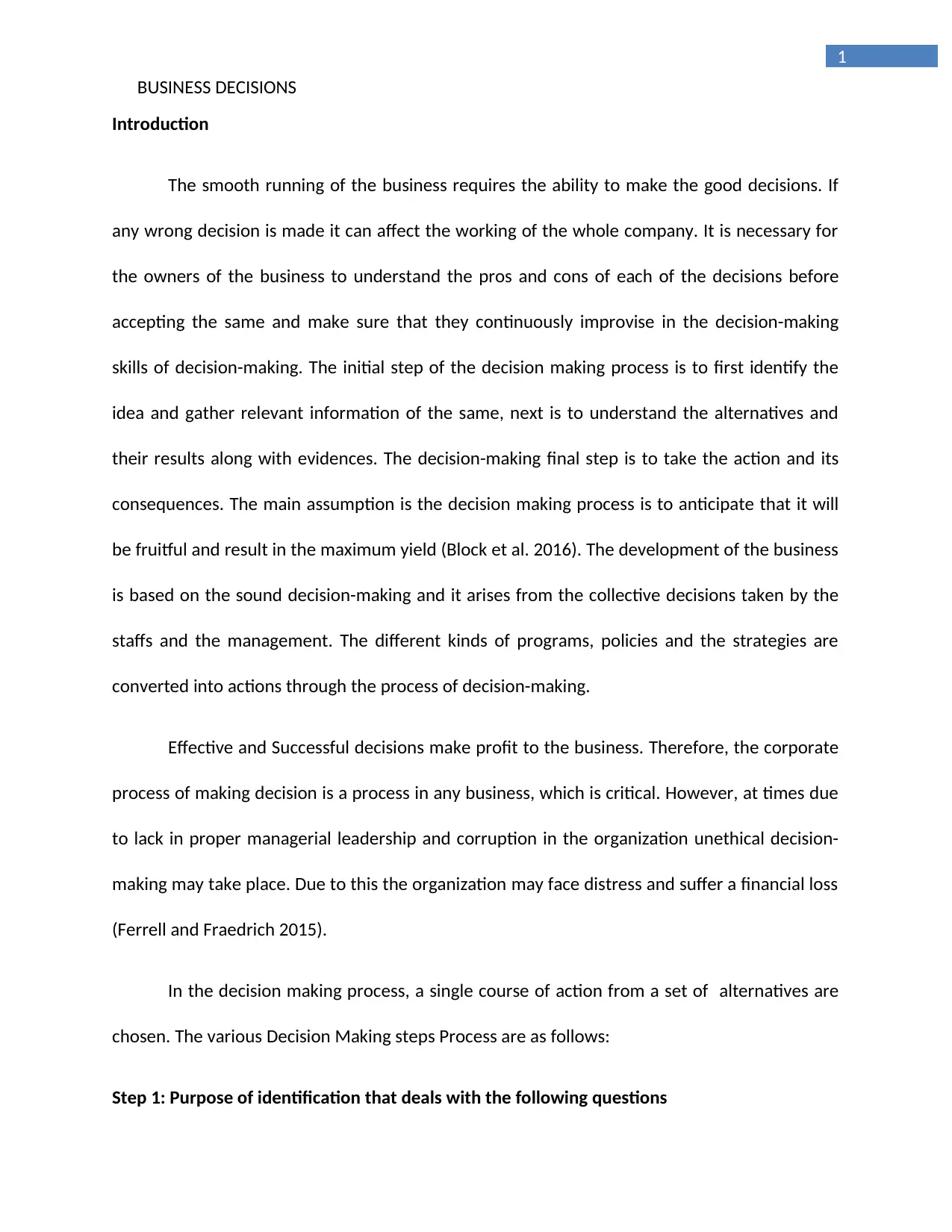
1
BUSINESS DECISIONS
Introduction
The smooth running of the business requires the ability to make the good decisions. If
any wrong decision is made it can affect the working of the whole company. It is necessary for
the owners of the business to understand the pros and cons of each of the decisions before
accepting the same and make sure that they continuously improvise in the decision-making
skills of decision-making. The initial step of the decision making process is to first identify the
idea and gather relevant information of the same, next is to understand the alternatives and
their results along with evidences. The decision-making final step is to take the action and its
consequences. The main assumption is the decision making process is to anticipate that it will
be fruitful and result in the maximum yield (Block et al. 2016). The development of the business
is based on the sound decision-making and it arises from the collective decisions taken by the
staffs and the management. The different kinds of programs, policies and the strategies are
converted into actions through the process of decision-making.
Effective and Successful decisions make profit to the business. Therefore, the corporate
process of making decision is a process in any business, which is critical. However, at times due
to lack in proper managerial leadership and corruption in the organization unethical decision-
making may take place. Due to this the organization may face distress and suffer a financial loss
(Ferrell and Fraedrich 2015).
In the decision making process, a single course of action from a set of alternatives are
chosen. The various Decision Making steps Process are as follows:
Step 1: Purpose of identification that deals with the following questions
BUSINESS DECISIONS
Introduction
The smooth running of the business requires the ability to make the good decisions. If
any wrong decision is made it can affect the working of the whole company. It is necessary for
the owners of the business to understand the pros and cons of each of the decisions before
accepting the same and make sure that they continuously improvise in the decision-making
skills of decision-making. The initial step of the decision making process is to first identify the
idea and gather relevant information of the same, next is to understand the alternatives and
their results along with evidences. The decision-making final step is to take the action and its
consequences. The main assumption is the decision making process is to anticipate that it will
be fruitful and result in the maximum yield (Block et al. 2016). The development of the business
is based on the sound decision-making and it arises from the collective decisions taken by the
staffs and the management. The different kinds of programs, policies and the strategies are
converted into actions through the process of decision-making.
Effective and Successful decisions make profit to the business. Therefore, the corporate
process of making decision is a process in any business, which is critical. However, at times due
to lack in proper managerial leadership and corruption in the organization unethical decision-
making may take place. Due to this the organization may face distress and suffer a financial loss
(Ferrell and Fraedrich 2015).
In the decision making process, a single course of action from a set of alternatives are
chosen. The various Decision Making steps Process are as follows:
Step 1: Purpose of identification that deals with the following questions
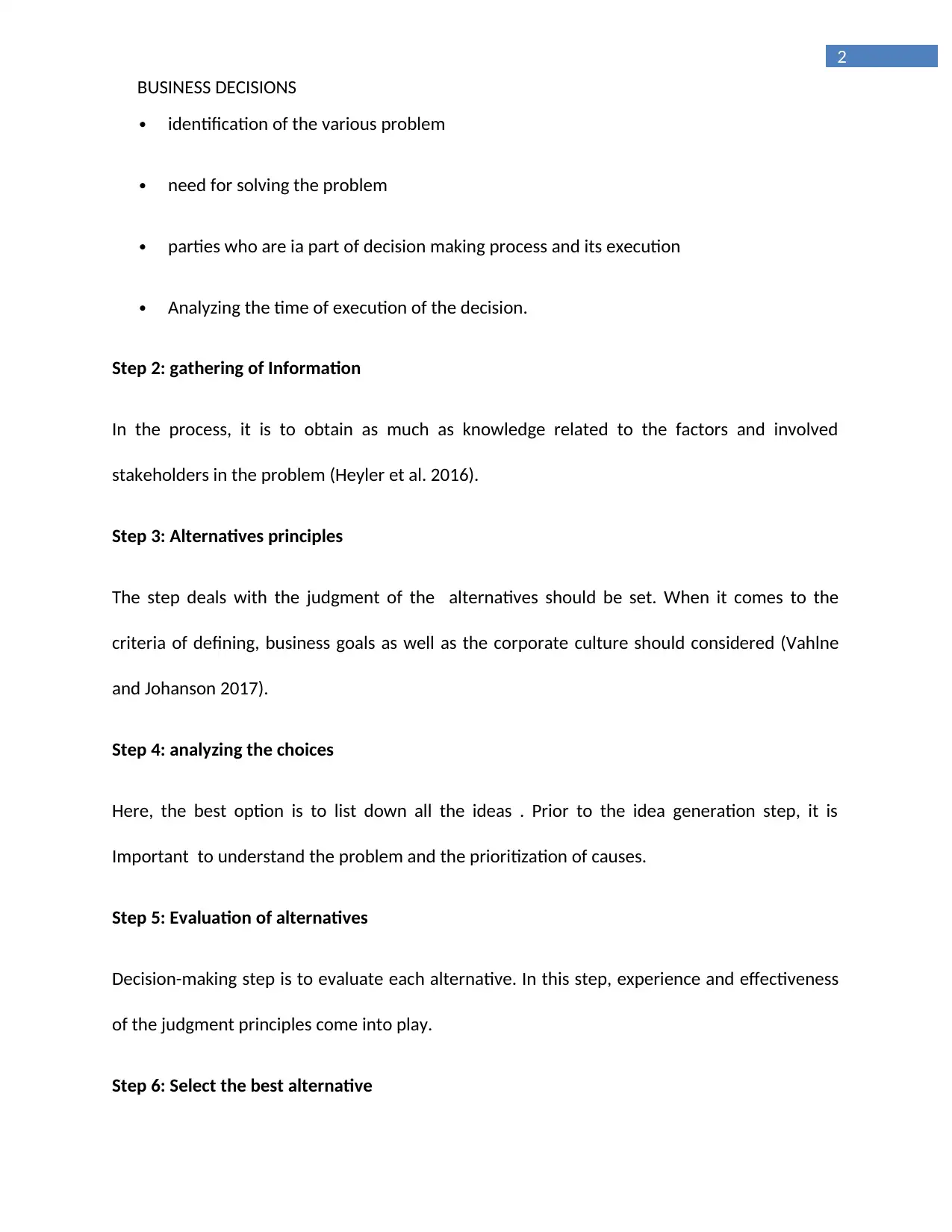
2
BUSINESS DECISIONS
identification of the various problem
need for solving the problem
parties who are ia part of decision making process and its execution
Analyzing the time of execution of the decision.
Step 2: gathering of Information
In the process, it is to obtain as much as knowledge related to the factors and involved
stakeholders in the problem (Heyler et al. 2016).
Step 3: Alternatives principles
The step deals with the judgment of the alternatives should be set. When it comes to the
criteria of defining, business goals as well as the corporate culture should considered (Vahlne
and Johanson 2017).
Step 4: analyzing the choices
Here, the best option is to list down all the ideas . Prior to the idea generation step, it is
Important to understand the problem and the prioritization of causes.
Step 5: Evaluation of alternatives
Decision-making step is to evaluate each alternative. In this step, experience and effectiveness
of the judgment principles come into play.
Step 6: Select the best alternative
BUSINESS DECISIONS
identification of the various problem
need for solving the problem
parties who are ia part of decision making process and its execution
Analyzing the time of execution of the decision.
Step 2: gathering of Information
In the process, it is to obtain as much as knowledge related to the factors and involved
stakeholders in the problem (Heyler et al. 2016).
Step 3: Alternatives principles
The step deals with the judgment of the alternatives should be set. When it comes to the
criteria of defining, business goals as well as the corporate culture should considered (Vahlne
and Johanson 2017).
Step 4: analyzing the choices
Here, the best option is to list down all the ideas . Prior to the idea generation step, it is
Important to understand the problem and the prioritization of causes.
Step 5: Evaluation of alternatives
Decision-making step is to evaluate each alternative. In this step, experience and effectiveness
of the judgment principles come into play.
Step 6: Select the best alternative
⊘ This is a preview!⊘
Do you want full access?
Subscribe today to unlock all pages.

Trusted by 1+ million students worldwide
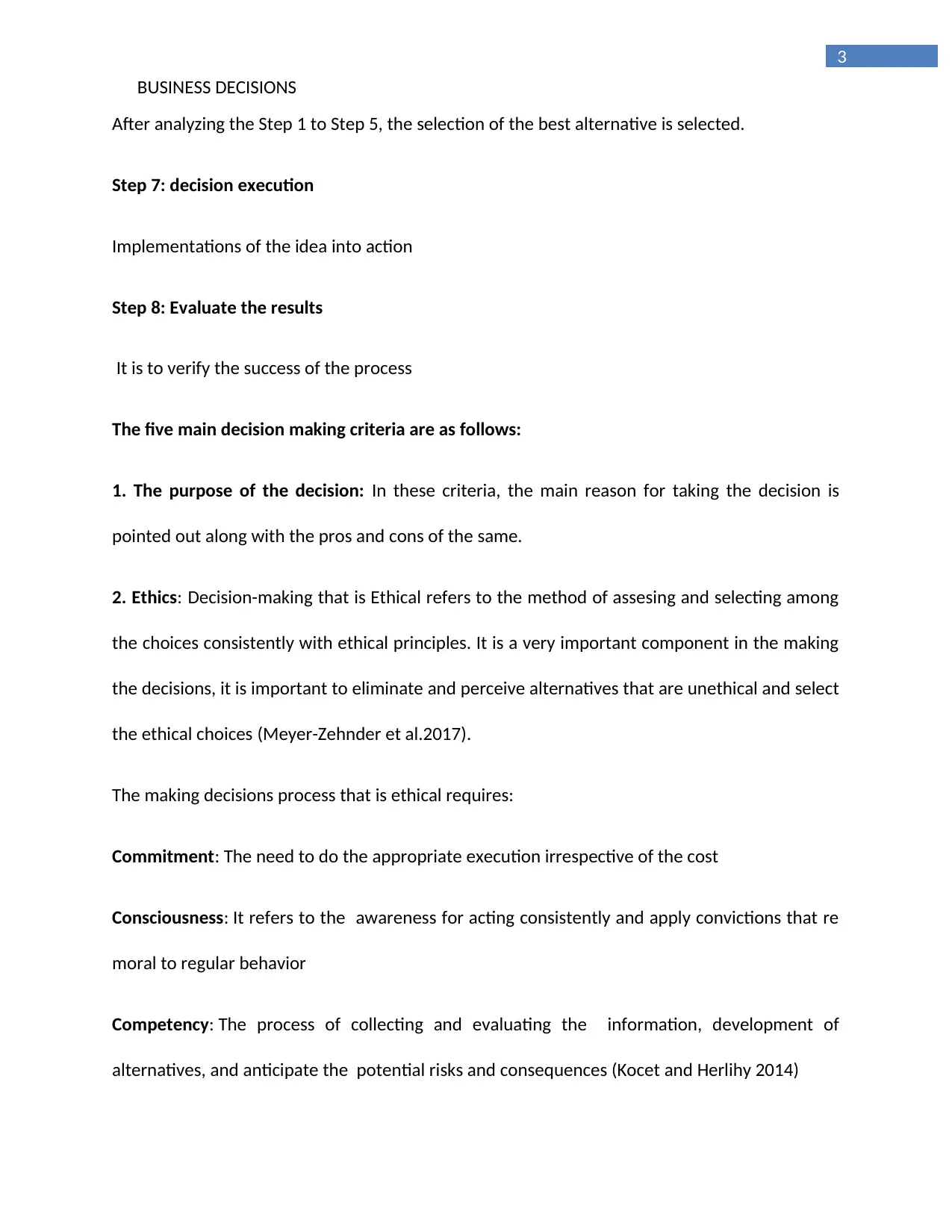
3
BUSINESS DECISIONS
After analyzing the Step 1 to Step 5, the selection of the best alternative is selected.
Step 7: decision execution
Implementations of the idea into action
Step 8: Evaluate the results
It is to verify the success of the process
The five main decision making criteria are as follows:
1. The purpose of the decision: In these criteria, the main reason for taking the decision is
pointed out along with the pros and cons of the same.
2. Ethics: Decision-making that is Ethical refers to the method of assesing and selecting among
the choices consistently with ethical principles. It is a very important component in the making
the decisions, it is important to eliminate and perceive alternatives that are unethical and select
the ethical choices (Meyer-Zehnder et al.2017).
The making decisions process that is ethical requires:
Commitment: The need to do the appropriate execution irrespective of the cost
Consciousness: It refers to the awareness for acting consistently and apply convictions that re
moral to regular behavior
Competency: The process of collecting and evaluating the information, development of
alternatives, and anticipate the potential risks and consequences (Kocet and Herlihy 2014)
BUSINESS DECISIONS
After analyzing the Step 1 to Step 5, the selection of the best alternative is selected.
Step 7: decision execution
Implementations of the idea into action
Step 8: Evaluate the results
It is to verify the success of the process
The five main decision making criteria are as follows:
1. The purpose of the decision: In these criteria, the main reason for taking the decision is
pointed out along with the pros and cons of the same.
2. Ethics: Decision-making that is Ethical refers to the method of assesing and selecting among
the choices consistently with ethical principles. It is a very important component in the making
the decisions, it is important to eliminate and perceive alternatives that are unethical and select
the ethical choices (Meyer-Zehnder et al.2017).
The making decisions process that is ethical requires:
Commitment: The need to do the appropriate execution irrespective of the cost
Consciousness: It refers to the awareness for acting consistently and apply convictions that re
moral to regular behavior
Competency: The process of collecting and evaluating the information, development of
alternatives, and anticipate the potential risks and consequences (Kocet and Herlihy 2014)
Paraphrase This Document
Need a fresh take? Get an instant paraphrase of this document with our AI Paraphraser
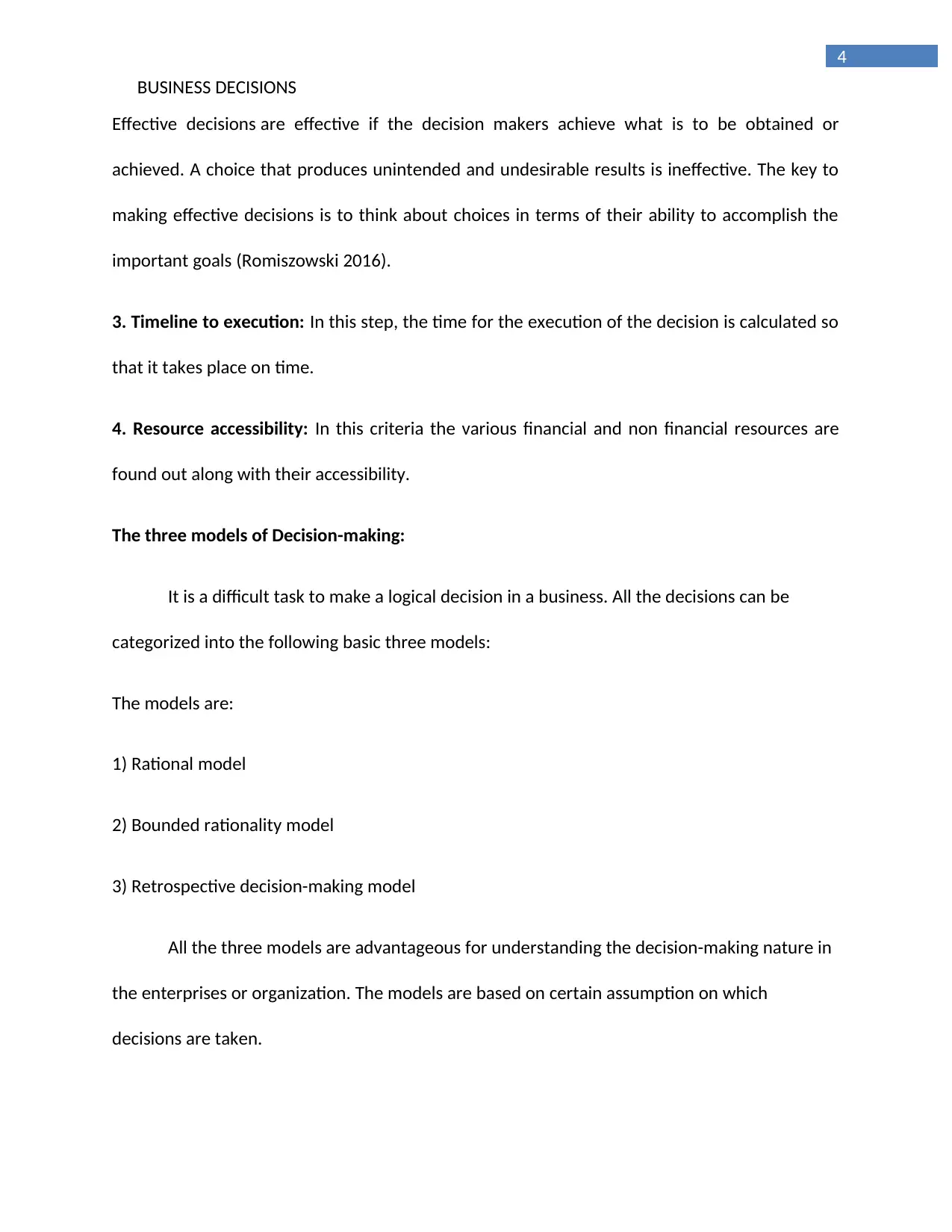
4
BUSINESS DECISIONS
Effective decisions are effective if the decision makers achieve what is to be obtained or
achieved. A choice that produces unintended and undesirable results is ineffective. The key to
making effective decisions is to think about choices in terms of their ability to accomplish the
important goals (Romiszowski 2016).
3. Timeline to execution: In this step, the time for the execution of the decision is calculated so
that it takes place on time.
4. Resource accessibility: In this criteria the various financial and non financial resources are
found out along with their accessibility.
The three models of Decision-making:
It is a difficult task to make a logical decision in a business. All the decisions can be
categorized into the following basic three models:
The models are:
1) Rational model
2) Bounded rationality model
3) Retrospective decision-making model
All the three models are advantageous for understanding the decision-making nature in
the enterprises or organization. The models are based on certain assumption on which
decisions are taken.
BUSINESS DECISIONS
Effective decisions are effective if the decision makers achieve what is to be obtained or
achieved. A choice that produces unintended and undesirable results is ineffective. The key to
making effective decisions is to think about choices in terms of their ability to accomplish the
important goals (Romiszowski 2016).
3. Timeline to execution: In this step, the time for the execution of the decision is calculated so
that it takes place on time.
4. Resource accessibility: In this criteria the various financial and non financial resources are
found out along with their accessibility.
The three models of Decision-making:
It is a difficult task to make a logical decision in a business. All the decisions can be
categorized into the following basic three models:
The models are:
1) Rational model
2) Bounded rationality model
3) Retrospective decision-making model
All the three models are advantageous for understanding the decision-making nature in
the enterprises or organization. The models are based on certain assumption on which
decisions are taken.
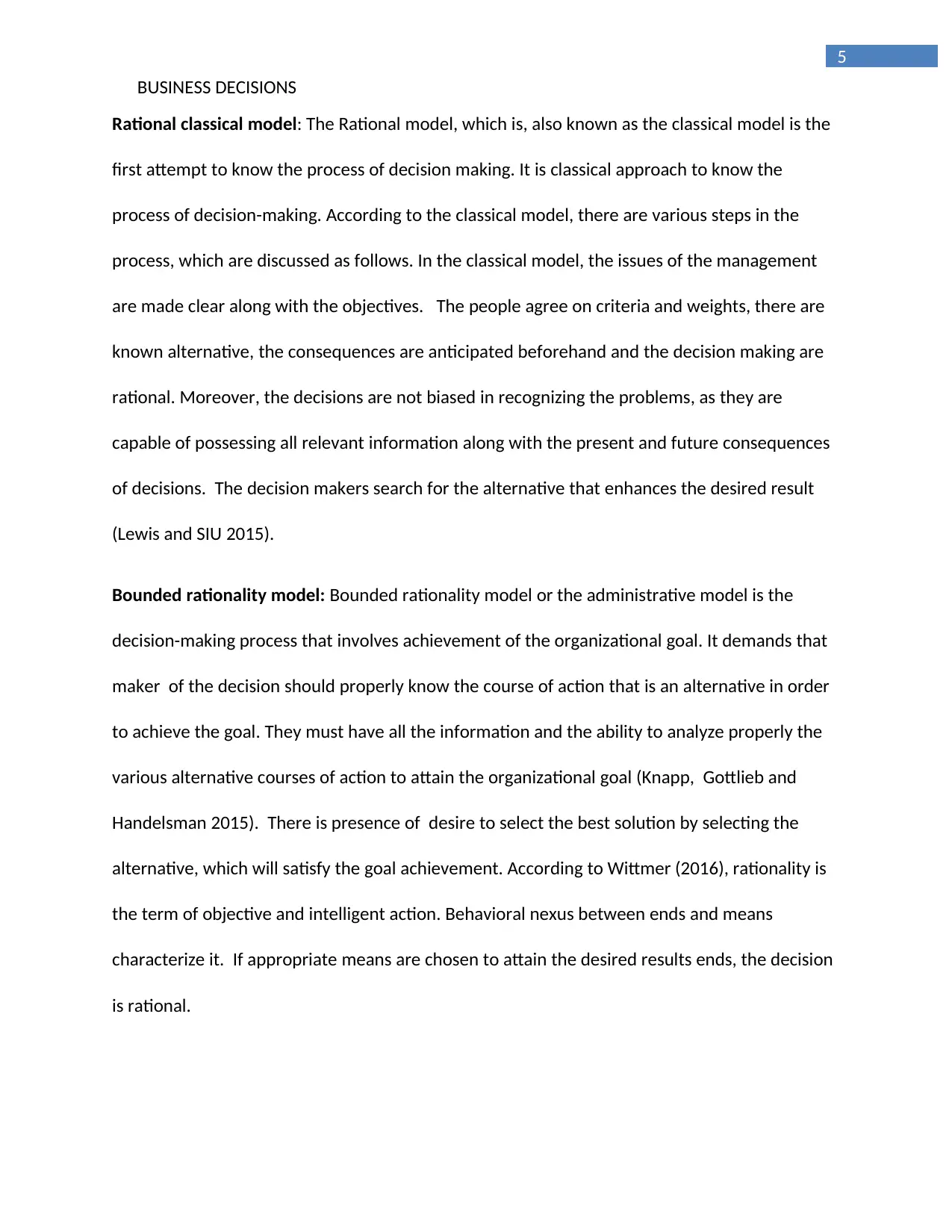
5
BUSINESS DECISIONS
Rational classical model: The Rational model, which is, also known as the classical model is the
first attempt to know the process of decision making. It is classical approach to know the
process of decision-making. According to the classical model, there are various steps in the
process, which are discussed as follows. In the classical model, the issues of the management
are made clear along with the objectives. The people agree on criteria and weights, there are
known alternative, the consequences are anticipated beforehand and the decision making are
rational. Moreover, the decisions are not biased in recognizing the problems, as they are
capable of possessing all relevant information along with the present and future consequences
of decisions. The decision makers search for the alternative that enhances the desired result
(Lewis and SIU 2015).
Bounded rationality model: Bounded rationality model or the administrative model is the
decision-making process that involves achievement of the organizational goal. It demands that
maker of the decision should properly know the course of action that is an alternative in order
to achieve the goal. They must have all the information and the ability to analyze properly the
various alternative courses of action to attain the organizational goal (Knapp, Gottlieb and
Handelsman 2015). There is presence of desire to select the best solution by selecting the
alternative, which will satisfy the goal achievement. According to Wittmer (2016), rationality is
the term of objective and intelligent action. Behavioral nexus between ends and means
characterize it. If appropriate means are chosen to attain the desired results ends, the decision
is rational.
BUSINESS DECISIONS
Rational classical model: The Rational model, which is, also known as the classical model is the
first attempt to know the process of decision making. It is classical approach to know the
process of decision-making. According to the classical model, there are various steps in the
process, which are discussed as follows. In the classical model, the issues of the management
are made clear along with the objectives. The people agree on criteria and weights, there are
known alternative, the consequences are anticipated beforehand and the decision making are
rational. Moreover, the decisions are not biased in recognizing the problems, as they are
capable of possessing all relevant information along with the present and future consequences
of decisions. The decision makers search for the alternative that enhances the desired result
(Lewis and SIU 2015).
Bounded rationality model: Bounded rationality model or the administrative model is the
decision-making process that involves achievement of the organizational goal. It demands that
maker of the decision should properly know the course of action that is an alternative in order
to achieve the goal. They must have all the information and the ability to analyze properly the
various alternative courses of action to attain the organizational goal (Knapp, Gottlieb and
Handelsman 2015). There is presence of desire to select the best solution by selecting the
alternative, which will satisfy the goal achievement. According to Wittmer (2016), rationality is
the term of objective and intelligent action. Behavioral nexus between ends and means
characterize it. If appropriate means are chosen to attain the desired results ends, the decision
is rational.
⊘ This is a preview!⊘
Do you want full access?
Subscribe today to unlock all pages.

Trusted by 1+ million students worldwide
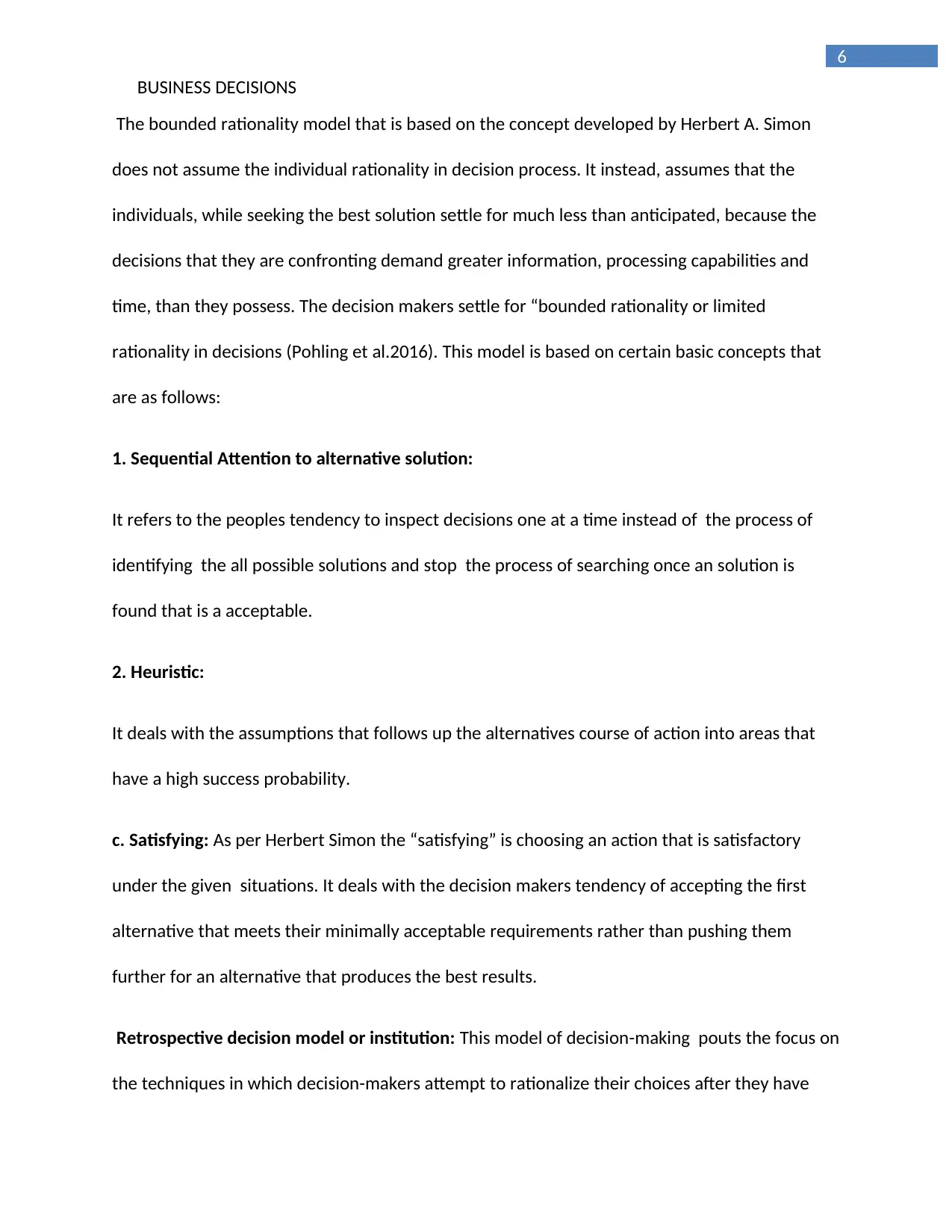
6
BUSINESS DECISIONS
The bounded rationality model that is based on the concept developed by Herbert A. Simon
does not assume the individual rationality in decision process. It instead, assumes that the
individuals, while seeking the best solution settle for much less than anticipated, because the
decisions that they are confronting demand greater information, processing capabilities and
time, than they possess. The decision makers settle for “bounded rationality or limited
rationality in decisions (Pohling et al.2016). This model is based on certain basic concepts that
are as follows:
1. Sequential Attention to alternative solution:
It refers to the peoples tendency to inspect decisions one at a time instead of the process of
identifying the all possible solutions and stop the process of searching once an solution is
found that is a acceptable.
2. Heuristic:
It deals with the assumptions that follows up the alternatives course of action into areas that
have a high success probability.
c. Satisfying: As per Herbert Simon the “satisfying” is choosing an action that is satisfactory
under the given situations. It deals with the decision makers tendency of accepting the first
alternative that meets their minimally acceptable requirements rather than pushing them
further for an alternative that produces the best results.
Retrospective decision model or institution: This model of decision-making pouts the focus on
the techniques in which decision-makers attempt to rationalize their choices after they have
BUSINESS DECISIONS
The bounded rationality model that is based on the concept developed by Herbert A. Simon
does not assume the individual rationality in decision process. It instead, assumes that the
individuals, while seeking the best solution settle for much less than anticipated, because the
decisions that they are confronting demand greater information, processing capabilities and
time, than they possess. The decision makers settle for “bounded rationality or limited
rationality in decisions (Pohling et al.2016). This model is based on certain basic concepts that
are as follows:
1. Sequential Attention to alternative solution:
It refers to the peoples tendency to inspect decisions one at a time instead of the process of
identifying the all possible solutions and stop the process of searching once an solution is
found that is a acceptable.
2. Heuristic:
It deals with the assumptions that follows up the alternatives course of action into areas that
have a high success probability.
c. Satisfying: As per Herbert Simon the “satisfying” is choosing an action that is satisfactory
under the given situations. It deals with the decision makers tendency of accepting the first
alternative that meets their minimally acceptable requirements rather than pushing them
further for an alternative that produces the best results.
Retrospective decision model or institution: This model of decision-making pouts the focus on
the techniques in which decision-makers attempt to rationalize their choices after they have
Paraphrase This Document
Need a fresh take? Get an instant paraphrase of this document with our AI Paraphraser
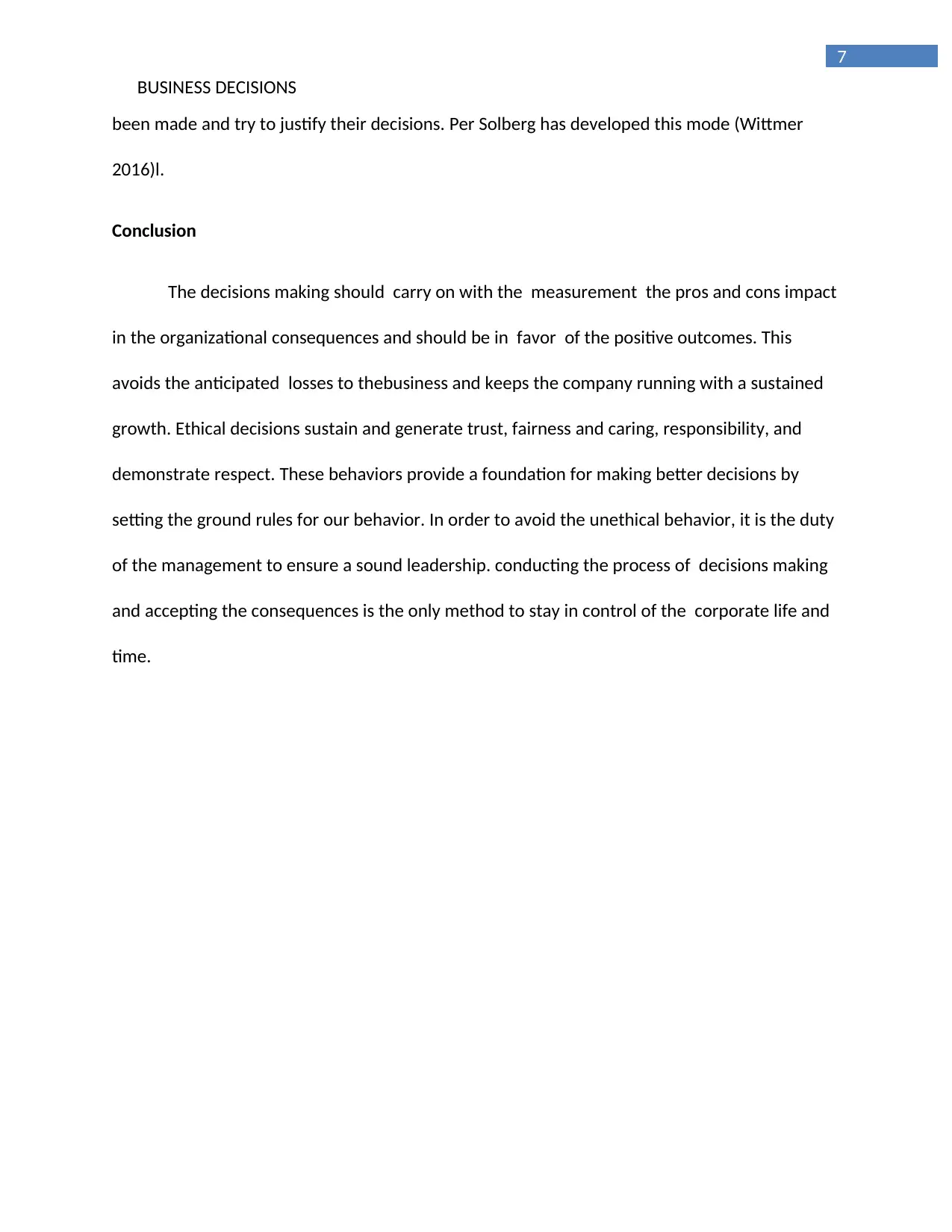
7
BUSINESS DECISIONS
been made and try to justify their decisions. Per Solberg has developed this mode (Wittmer
2016)l.
Conclusion
The decisions making should carry on with the measurement the pros and cons impact
in the organizational consequences and should be in favor of the positive outcomes. This
avoids the anticipated losses to thebusiness and keeps the company running with a sustained
growth. Ethical decisions sustain and generate trust, fairness and caring, responsibility, and
demonstrate respect. These behaviors provide a foundation for making better decisions by
setting the ground rules for our behavior. In order to avoid the unethical behavior, it is the duty
of the management to ensure a sound leadership. conducting the process of decisions making
and accepting the consequences is the only method to stay in control of the corporate life and
time.
BUSINESS DECISIONS
been made and try to justify their decisions. Per Solberg has developed this mode (Wittmer
2016)l.
Conclusion
The decisions making should carry on with the measurement the pros and cons impact
in the organizational consequences and should be in favor of the positive outcomes. This
avoids the anticipated losses to thebusiness and keeps the company running with a sustained
growth. Ethical decisions sustain and generate trust, fairness and caring, responsibility, and
demonstrate respect. These behaviors provide a foundation for making better decisions by
setting the ground rules for our behavior. In order to avoid the unethical behavior, it is the duty
of the management to ensure a sound leadership. conducting the process of decisions making
and accepting the consequences is the only method to stay in control of the corporate life and
time.
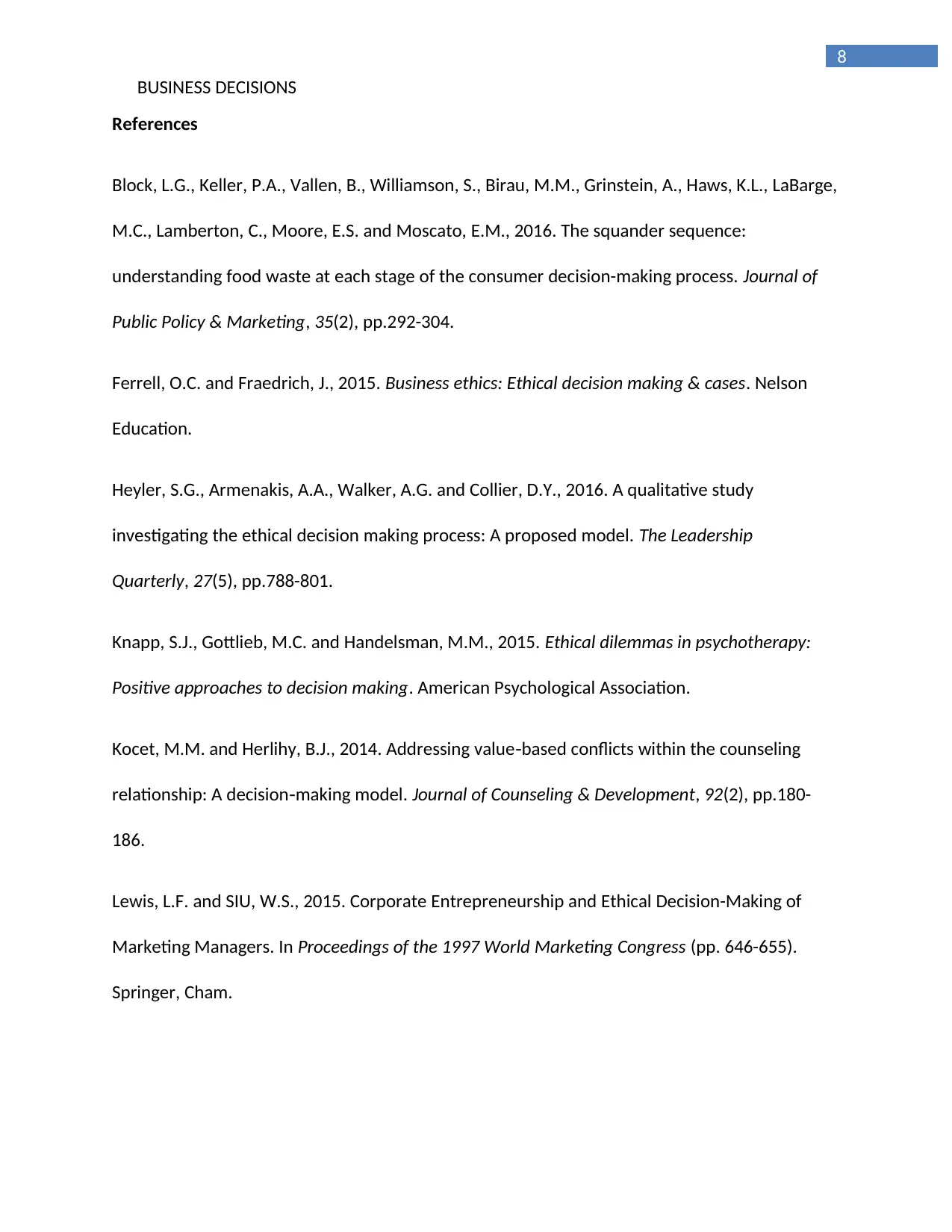
8
BUSINESS DECISIONS
References
Block, L.G., Keller, P.A., Vallen, B., Williamson, S., Birau, M.M., Grinstein, A., Haws, K.L., LaBarge,
M.C., Lamberton, C., Moore, E.S. and Moscato, E.M., 2016. The squander sequence:
understanding food waste at each stage of the consumer decision-making process. Journal of
Public Policy & Marketing, 35(2), pp.292-304.
Ferrell, O.C. and Fraedrich, J., 2015. Business ethics: Ethical decision making & cases. Nelson
Education.
Heyler, S.G., Armenakis, A.A., Walker, A.G. and Collier, D.Y., 2016. A qualitative study
investigating the ethical decision making process: A proposed model. The Leadership
Quarterly, 27(5), pp.788-801.
Knapp, S.J., Gottlieb, M.C. and Handelsman, M.M., 2015. Ethical dilemmas in psychotherapy:
Positive approaches to decision making. American Psychological Association.
Kocet, M.M. and Herlihy, B.J., 2014. Addressing value based conflicts within the counseling‐
relationship: A decision making model.‐ Journal of Counseling & Development, 92(2), pp.180-
186.
Lewis, L.F. and SIU, W.S., 2015. Corporate Entrepreneurship and Ethical Decision-Making of
Marketing Managers. In Proceedings of the 1997 World Marketing Congress (pp. 646-655).
Springer, Cham.
BUSINESS DECISIONS
References
Block, L.G., Keller, P.A., Vallen, B., Williamson, S., Birau, M.M., Grinstein, A., Haws, K.L., LaBarge,
M.C., Lamberton, C., Moore, E.S. and Moscato, E.M., 2016. The squander sequence:
understanding food waste at each stage of the consumer decision-making process. Journal of
Public Policy & Marketing, 35(2), pp.292-304.
Ferrell, O.C. and Fraedrich, J., 2015. Business ethics: Ethical decision making & cases. Nelson
Education.
Heyler, S.G., Armenakis, A.A., Walker, A.G. and Collier, D.Y., 2016. A qualitative study
investigating the ethical decision making process: A proposed model. The Leadership
Quarterly, 27(5), pp.788-801.
Knapp, S.J., Gottlieb, M.C. and Handelsman, M.M., 2015. Ethical dilemmas in psychotherapy:
Positive approaches to decision making. American Psychological Association.
Kocet, M.M. and Herlihy, B.J., 2014. Addressing value based conflicts within the counseling‐
relationship: A decision making model.‐ Journal of Counseling & Development, 92(2), pp.180-
186.
Lewis, L.F. and SIU, W.S., 2015. Corporate Entrepreneurship and Ethical Decision-Making of
Marketing Managers. In Proceedings of the 1997 World Marketing Congress (pp. 646-655).
Springer, Cham.
⊘ This is a preview!⊘
Do you want full access?
Subscribe today to unlock all pages.

Trusted by 1+ million students worldwide
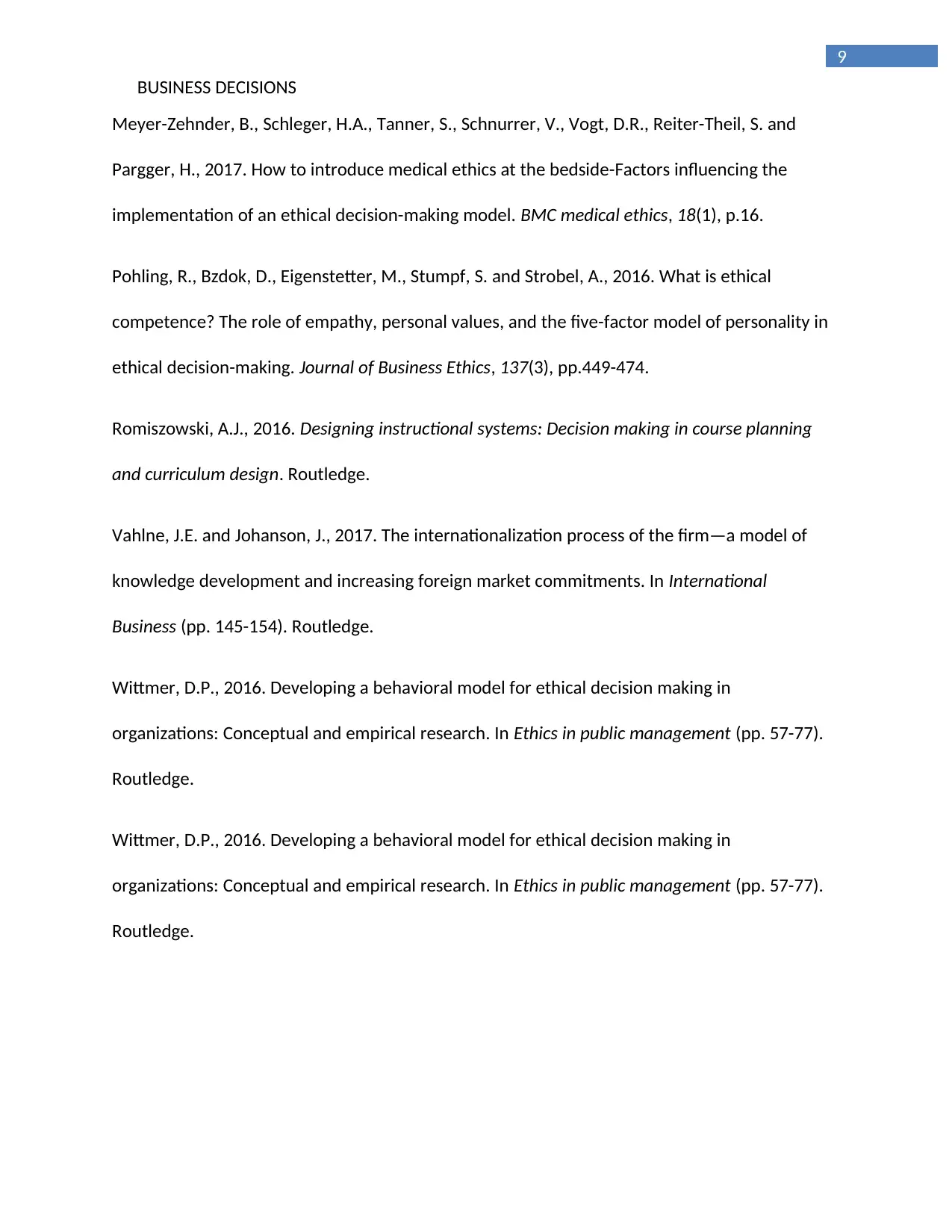
9
BUSINESS DECISIONS
Meyer-Zehnder, B., Schleger, H.A., Tanner, S., Schnurrer, V., Vogt, D.R., Reiter-Theil, S. and
Pargger, H., 2017. How to introduce medical ethics at the bedside-Factors influencing the
implementation of an ethical decision-making model. BMC medical ethics, 18(1), p.16.
Pohling, R., Bzdok, D., Eigenstetter, M., Stumpf, S. and Strobel, A., 2016. What is ethical
competence? The role of empathy, personal values, and the five-factor model of personality in
ethical decision-making. Journal of Business Ethics, 137(3), pp.449-474.
Romiszowski, A.J., 2016. Designing instructional systems: Decision making in course planning
and curriculum design. Routledge.
Vahlne, J.E. and Johanson, J., 2017. The internationalization process of the firm—a model of
knowledge development and increasing foreign market commitments. In International
Business (pp. 145-154). Routledge.
Wittmer, D.P., 2016. Developing a behavioral model for ethical decision making in
organizations: Conceptual and empirical research. In Ethics in public management (pp. 57-77).
Routledge.
Wittmer, D.P., 2016. Developing a behavioral model for ethical decision making in
organizations: Conceptual and empirical research. In Ethics in public management (pp. 57-77).
Routledge.
BUSINESS DECISIONS
Meyer-Zehnder, B., Schleger, H.A., Tanner, S., Schnurrer, V., Vogt, D.R., Reiter-Theil, S. and
Pargger, H., 2017. How to introduce medical ethics at the bedside-Factors influencing the
implementation of an ethical decision-making model. BMC medical ethics, 18(1), p.16.
Pohling, R., Bzdok, D., Eigenstetter, M., Stumpf, S. and Strobel, A., 2016. What is ethical
competence? The role of empathy, personal values, and the five-factor model of personality in
ethical decision-making. Journal of Business Ethics, 137(3), pp.449-474.
Romiszowski, A.J., 2016. Designing instructional systems: Decision making in course planning
and curriculum design. Routledge.
Vahlne, J.E. and Johanson, J., 2017. The internationalization process of the firm—a model of
knowledge development and increasing foreign market commitments. In International
Business (pp. 145-154). Routledge.
Wittmer, D.P., 2016. Developing a behavioral model for ethical decision making in
organizations: Conceptual and empirical research. In Ethics in public management (pp. 57-77).
Routledge.
Wittmer, D.P., 2016. Developing a behavioral model for ethical decision making in
organizations: Conceptual and empirical research. In Ethics in public management (pp. 57-77).
Routledge.
Paraphrase This Document
Need a fresh take? Get an instant paraphrase of this document with our AI Paraphraser

10
BUSINESS DECISIONS
1.
BUSINESS DECISIONS
1.

11
BUSINESS DECISIONS
BUSINESS DECISIONS
⊘ This is a preview!⊘
Do you want full access?
Subscribe today to unlock all pages.

Trusted by 1+ million students worldwide
1 out of 12
Related Documents
Your All-in-One AI-Powered Toolkit for Academic Success.
+13062052269
info@desklib.com
Available 24*7 on WhatsApp / Email
![[object Object]](/_next/static/media/star-bottom.7253800d.svg)
Unlock your academic potential
Copyright © 2020–2025 A2Z Services. All Rights Reserved. Developed and managed by ZUCOL.





